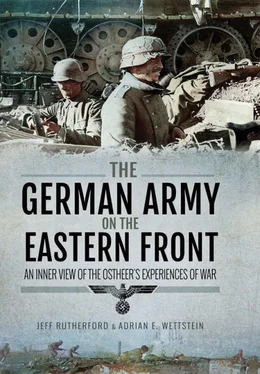In individual cases, the unfair distribution of personal goods and leave cards and a better life for officers has been complained about.
As the report indicates, by summer 1943 doubts about Germany’s victory in the war permeated the ranks, and it was precisely this phenomenon that so alarmed the German political and military leadership. As detailed above, part of the army’s approach to this morale crisis was to ratchet up the ideological indoctrination. Complementing this was an increasingly politicized judicial system, which served two purposes. In the literature, German military justice has been described as traditionally severe. While this was certainly the case in the days of Frederick the Great, the Imperial German army took a much less violent approach to discipline than many of its contemporaries. During the First World War, the Italian, French, and British armies executed far more men than the Kaiserheer . By the time of the Second World War, this was no longer the case and only the Soviet Union shot more of its own soldiers than the German army’s 19,600 victims from its own ranks. [43]
On the one hand, the military justice system utilized terror as a means of coercing German soldiers to man their positions in the face of enemy superiority by recourse to the death penalty as a pedagogic tool. On the other hand, it also attempted to ‘use the labour power of a man for as long as possible’ and troops whose offenses were not seen to fundamentally threaten the army’s cohesion were funnelled back to the front. [44]This dual nature was made clear in a report issued by the 8th Panzer Division’s divisional court for the first half of 1942. [45]
In the reporting period, 208 criminal proceedings were carried out. Of these, 86 cases led to convictions. The rest of the proceedings were dismissed or settled in a different way. The number of carried out proceedings was small, especially during the time of the advance. The enforcing of the punishment was predominantly suspended especially during the time of operations in order to avoid convicted soldiers being preserved in prisons while unpunished soldiers found themselves at the front.
The following military offences emerged as the most common during the reporting period: military theft, breach of guard duty, and unauthorized absence.
The total number of criminal cases was higher than in the previous half year, though it must be considered that during the reporting period, the troops found themselves more stationary.
In one case, a death sentence was pronounced.
Elements of military necessity emerge from this document; while the army needed to impose discipline in the ranks to keep its organizational integrity, it also realized that locking men in prison deprived the front of much needed manpower, and since sentenced soldiers would stay in the safety of prisons, this could also influence troops’ morale negatively. German military justice increasingly radicalized during the conflict, but it is clear that the war in the east provided the real impetus to this process. This was partially due to how soldiers viewed the struggle: as a seemingly interminable conflict that simply ground them – and their enthusiasm for war – down to a blunt edge. A report issued by the 205th Infantry Division commander drew attention to a company where professionalism and discipline had clearly been eroded under the strain of war in the east. [46]
On 5.12.42 from 11.00 to 13.30 the divisional commander inspected the positions of the 3rd/ Jäger Battalion 6 at the anti-tank ditch near Kashino. On the previous evening, the troops were informed of the appearance of 300 trucks north of Velizh and had been advised for increased attentiveness.
The divisional commander walked along the length of the whole anti-tank ditch, without meeting a soldier or discovering any footprints in the snow. The ditch and the branching-off saps were covered in snow drifts, the ditch was in places buried by earth works and was no longer an absolute tank obstacle. Weapons lay around, unsecured and filthy.
No sentry reported in the forest corner eastward of the ditch despite repeated loud calls. The Jäger (riflemen) Bolzer just left his sentry position before the Jäger Urbanke relieved him. The light machine gun 42 positioned there was unguarded in this time span.
Neither the aforementioned Jäger nor the group leader, Oberjäger Gruber, who was brought to the area, were knowledgeable about the enemy situation. Contact to the left had been established by a patrol until eight days ago. The divisional commander caused an alarm to go off at an available wire line. When he left after 5 minutes, no man had yet arrived.
The company chief, Oberleutnant Hieselt, who had been brought to the area (older officer, First World War participant), reported after a quarter of an hour and stated that he had been in another part of his sector. He declared that he had informed his platoon leaders about the enemy situation.
Shortly afterwards the battalion commander, Hauptmann Rheinheimer, reported without shoulderboards. The divisional commander made him aware of the contradictory order and walked with him along the position again. In the shelters and on the sentry positions, great disorder predominated. Wooden cover panels were broken out, shells laid around in large quantities. When the divisional commander wanted a heavy machine gun sentry to open fire (the machine gun was unloaded), it turned out that this one was not trained on the heavy machine gun and could not open fire. Two German hand grenades lay in the snow. Russian hand grenades that were never tried were placed in a case. The soldiers had no confidence in them.
In response to the division commander’s question, Oberleutnant Hieselt reported that the night patrols had a strength of 2 men and patrolled at the top of the ditch in contradiction to the divisional order, according to which the patrols must have sufficient combat strength and must use the ditch to avoid unnecessary losses.
The Jäger were partly unshaven. No formal report was given at all.
As this report indicated, even front-line units failed to always take their duties seriously due to the burnout suffered by men continually manning their positions. In the particular case of this battalion, the situation was exacerbated by it being independently formed during the winter crisis and immediately thrown into battle in early 1942. The high command feared that the erosion of discipline would eventually result in an army that was both unwilling and unable to defend the Reich against the Red Army. Thus, its need to keep its men in the field, combined with the growing influence of Nazi beliefs and values, led to a transformation of the army’s judicial system into one that routinely employed terror against its own men. Relatively minor offenses, such as falling asleep on sentry duty, were viewed through the prism of ideology, while an entire series of offenses – including desertion and self-inflicted wounds – was grouped under the heading of Wehrkraftzersetzung , or subversion of the war effort. The act of desertion struck both the army and the Nazi state at their core; for the former, deserters abandoned their comrades and increased the likelihood of defeat on the battlefield, while the latter viewed them as race traitors who betrayed the living organism of the Third Reich. The army’s view of deserters – one that clearly connects the military and social problems together – is perhaps best encapsulated in a document issued by 8th Panzer Division in October 1942.
1) Measures against Deserters
In a time of the highest mental and physical exertions on the front and in the Heimat , the criminal elements and psychopaths who want to evade their duties to this Frontgemeinschaft must be prevented with the use of all means.
Читать дальше






![John Stieber - Against the Odds - Survival on the Russian Front 1944-1945 [2nd Edition]](/books/405234/john-stieber-against-the-odds-survival-on-the-russian-front-1944-1945-2nd-edition-thumb.webp)





